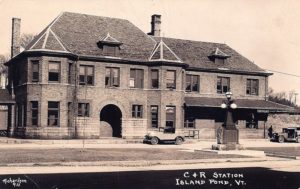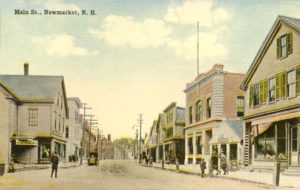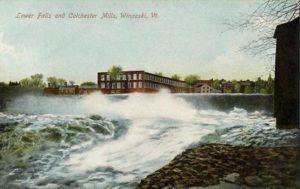Last week, on this blog, I listed ten major surveys and monographs on Franco-American history in hopes of providing a basis for preliminary research. Equally important are studies published in scholarly journals. I have selected the following ten partly because of their effect on the overall scholarly conversation, but also because they address topics sometimes neglected by historical surveys.
Again, this is not definitive guide, nor is it meant to disparage works that are not listed. This is a “starter pack” that will hopefully help researchers get a general sense of the field and invite them to dig deeper.
For unaffiliated researchers, some of the articles below are available online free of charge; others may be accessed at your nearest academic library. You can find more information about online resources on Franco-Americans at this blog; you may also consider consulting my recent bibliography on the subject.
1. Mason WADE, “The French Parish and Survivance in Nineteenth-Century New England,” Catholic Historical Review, 36-2 (1950), pp. 163-189.
Several authors before Wade (notably Fr. Edouard Hamon) had endeavored to chronicle the early organization of French-Canadian religious life in the United States. But Wade’s work offered unprecedented precision and a richness of detail. He combined missionary efforts and individual parish histories into a powerful synopsis of early exertions for cultural recognition within the U.S. Catholic Church. The article exposes the tension between the legacy of Quebec Church culture and the U.S. Church’s own traditions and aspirations.
2. James P. ALLEN, “Migration Fields of French Canadian Immigrants to Southern Maine,” Geographical Review, 62-3 (1972), pp. 366-383.
Allen quite literally maps areas of French-Canadian settlement in Maine, tracing the transplantation of communities before and after railway construction. He in fact charts the changing places of origins and destinations of migrants up to the 1920s. Naturally, mills mattered in the making of canadien emigration. But so did roads (iron and otherwise), means of transportation, and the cost of travel. The maps are a wonderful tool; Allen’s brief and cogent study is a valuable point of entry into the subject.
3. Richard SORRELL, “Sentinelle Affair (1924-1929) – Religion and Militant Survivance in Woonsocket, Rhode Island,” Rhode Island History, 36-3 (1977), pp. 67-79.
Surveys of Franco-American history typically consider three significant ethnic controversies—the Massachusetts Bureau of Labor Statistics report and the Wright hearings (1882), the Flint Affair (1884-1886), and the Sentinelle Affair (1924-1928). Sorrell tackles the last of these, providing a concise, balanced assessment of a controversy that marked the definitive assertion of episcopal authority over Franco-American religious and cultural aspirations.

4. Peter WOOLFSON, “The Rural Franco-American in Vermont,” Vermont History, 50-3 (1982), pp. 151-162.
Proportionally, immigration to Vermont declined in favor of other New England states after the U.S. Civil War, but by no means did it end. Woolfson chronicles Franco-American community life from the border towns of Franklin County to Beecher Falls in the decades after 1920. He thus brings much-needed attention to Franco-Americans in rural areas and “mini-mill towns.” He also depicts customs carried over from Quebec and finds hints of survivance still at the dawn of the 1980s.
5. Robert G. LeBLANC, “The Franco-American Response to the Conscription Crisis in Canada, 1916-1918,” American Review of Canadian Studies, 23-3 (1993), pp. 343-372.
When did the French-speaking peoples of Canada and Franco-Americans become distinct groups? Even though the process was undoubtedly gradual, scholars still debate defining moments. The late, great Robert LeBlanc contrasted responses to the First World War on the two sides of the border and isolated differences in how French Canadians approached their countries’ participation. The split had less to do with different commitments to their ancestral culture than with the perceived meaning of U.S. citizenship.
6. Martin PAQUET, “‘Le meilleur immigrant’: le rapatrié des Etats-Unis comme catégorie pour les responsables politiques du Canada-Uni et du Québec, 1849-1968,” Francophonies d’Amérique 9 (1999), pp. 87-105.
It is easy to forget, amid U.S. perspectives on Franco-American history, that the migrants posed a serious public policy challenge in Quebec. For generations, the Quebec government pondered ways of halting, slowing, or preventing emigration. It is in fact impossible to separate emigration from the colonization projects (think Curé Labelle) proposed north of the border. In this fascinating piece, Paquet traces the lengthy debate over repatriation of potentially Americanized French-Canadians.

7. Florence Mae WALDRON, “‘I’ve Never Dreamed It Was Necessary to Marry!’: Women and Work in New England French Canadian Communities, 1870-1930,” Journal of American Ethnic History, 24-2 (2005), pp. 34-64.
This is an article about paid female work that transcends older literature on mill life. Waldron studies the impact of women’s labor on family formation in Lewiston, Worcester, and Manchester; in Lewiston, young women tended to delay marriage due to the availability of paid employment. The author notably finds that French-Canadian women embraced the opportunity to work outside of the home; their ability to earn money tended to deter them from moving back to Quebec. It was a form of liberation.
8. Adeline VASQUEZ-PARRA, “L’accueil des exiles acadiens suite au Grand-Dérangement dans la colonie du Massachusetts de 1755 à 1775,” International Journal of Canadian Studies 44 (2011), pp. 91-110.
The French-speaking migrants of the 1840s were not the first in New England. Nearly a century earlier, forcibly exiled Acadians had their own encounter with the region’s English-speaking, Congregationalist establishment. The author pays particular attention to the Acadians’ efforts to secure public support. Local authorities were wary of “popery” in their midst and the potential threat to their security—but also, and perhaps most of all, wary of the financial burden placed on their communities by the poor deportees.
9. Yves FRENETTE, “L’historiographie des Franco-Américains de la Nouvelle-Angleterre, 1872-2015,” Bulletin d’histoire politique, 24-2 (2016), pp. 75-103.
As I’ve noted elsewhere, Franco-American historians are prolific producers of historiographical essays. This one, the latest and possibly most comprehensive, is a precious tool for anyone starting research on Franco-American history. It traces the evolution of the field from the days of mass immigration to the present and explains the ways in which historical writing responded to contemporary concerns, from survivance to social history and beyond. A strong English-language counterpart, also worth reading, is Sacha Richard’s piece in the Canadian Review of American Studies (2002).

10. Jason L. NEWTON, “‘These French Canadian of the Woods Are Half-Wild Folk’: Wilderness, Whiteness, and Work in North America, 1840-1955,” Labour/Le Travail 77 (2016), pp. 121-150.
At first glimpse this has all the makings of an ethnographic study—in an indirect way, it is. But Newton delves deeper and tackles questions that have long been on the margins of the historical conversation: Were Franco-Americans considered “white” or reaping the “wages of whiteness”? Were they considered racially distinct, i.e. did they have an essence different from that of Anglo-Saxon Americans? The article offers an extensive discussion of literature on race and of the conventional treatment (at least pre-Second World War) of Franco-Americans by U.S. intellectuals.
Leave a Reply